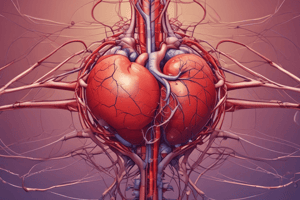Podcast
Questions and Answers
Which chamber of the heart receives deoxygenated blood from the body?
Which chamber of the heart receives deoxygenated blood from the body?
- Right ventricle
- Left atrium
- Right atrium (correct)
- Left ventricle
What is the function of the sinoatrial (SA) node?
What is the function of the sinoatrial (SA) node?
- To receive deoxygenated blood from the body
- To produce electrical impulses that stimulate the heart to beat (correct)
- To regulate blood pressure and circulation
- To pump blood throughout the body
What is the average rate of heartbeat in beats per minute?
What is the average rate of heartbeat in beats per minute?
- 90-100
- 80-90
- 60-70
- 70-80 (correct)
Which valve allows blood to flow from the right atrium to the right ventricle?
Which valve allows blood to flow from the right atrium to the right ventricle?
What happens to blood pressure as blood flows through the circulatory system?
What happens to blood pressure as blood flows through the circulatory system?
What is the function of the heart in relation to oxygenation of blood?
What is the function of the heart in relation to oxygenation of blood?
Flashcards are hidden until you start studying
Study Notes
Structure of the Heart
- The heart is a muscular organ that pumps blood throughout the body
- Located in the thoracic cavity, between the lungs
- Divided into four chambers:
- Right atrium (upper right chamber)
- Right ventricle (lower right chamber)
- Left atrium (upper left chamber)
- Left ventricle (lower left chamber)
Functions of the Heart
- Pumps blood throughout the body, supplying oxygen and nutrients to organs and tissues
- Receives deoxygenated blood from the body and pumps it to the lungs to be oxygenated
- Regulates blood pressure and circulation
Blood Flow Through the Heart
- Deoxygenated blood enters the right atrium through the superior and inferior vena cavae
- Blood flows from the right atrium to the right ventricle through the tricuspid valve
- Right ventricle pumps blood to the lungs through the pulmonary artery
- Oxygenated blood returns to the heart through the pulmonary veins and enters the left atrium
- Blood flows from the left atrium to the left ventricle through the mitral valve
- Left ventricle pumps blood to the rest of the body through the aorta
Heartbeat Regulation
- The heartbeat is regulated by the sinoatrial (SA) node, located in the right atrium
- The SA node produces electrical impulses that stimulate the heart to beat
- The atrioventricular (AV) node relays the electrical impulses from the SA node to the ventricles
Blood Pressure and Circulation
- The heart pumps blood at an average rate of 70-80 beats per minute
- Blood pressure is highest in the aorta and decreases as blood flows through the circulatory system
- The heart adjusts blood pressure and circulation in response to changes in the body's needs, such as during exercise or stress.
Structure of the Heart
- Located in the thoracic cavity, between the lungs
- Divided into four chambers: Right atrium, Right ventricle, Left atrium, Left ventricle
Functions of the Heart
- Pumps blood throughout the body, supplying oxygen and nutrients to organs and tissues
- Receives deoxygenated blood from the body and pumps it to the lungs to be oxygenated
- Regulates blood pressure and circulation
Blood Flow Through the Heart
- Deoxygenated blood enters the right atrium through the superior and inferior vena cavae
- Blood flows from the right atrium to the right ventricle through the tricuspid valve
- Right ventricle pumps blood to the lungs through the pulmonary artery
- Oxygenated blood returns to the heart through the pulmonary veins and enters the left atrium
- Blood flows from the left atrium to the left ventricle through the mitral valve
- Left ventricle pumps blood to the rest of the body through the aorta
Heartbeat Regulation
- The heartbeat is regulated by the sinoatrial (SA) node, located in the right atrium
- The SA node produces electrical impulses that stimulate the heart to beat
- The atrioventricular (AV) node relays the electrical impulses from the SA node to the ventricles
Blood Pressure and Circulation
- The heart pumps blood at an average rate of 70-80 beats per minute
- Blood pressure is highest in the aorta and decreases as blood flows through the circulatory system
- The heart adjusts blood pressure and circulation in response to changes in the body's needs
Studying That Suits You
Use AI to generate personalized quizzes and flashcards to suit your learning preferences.




